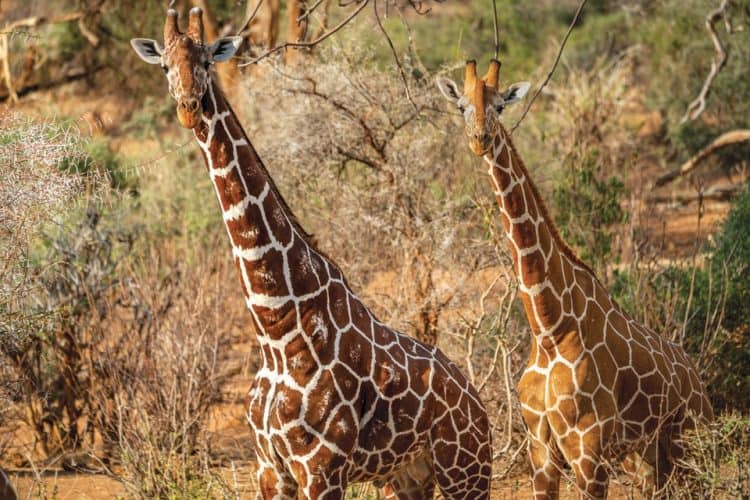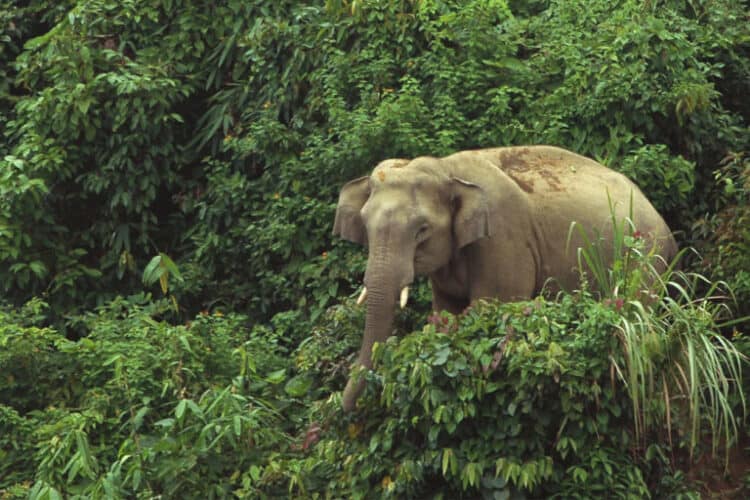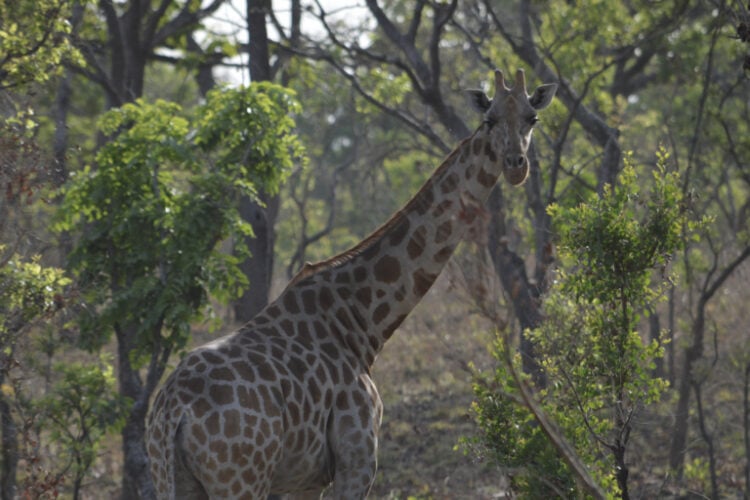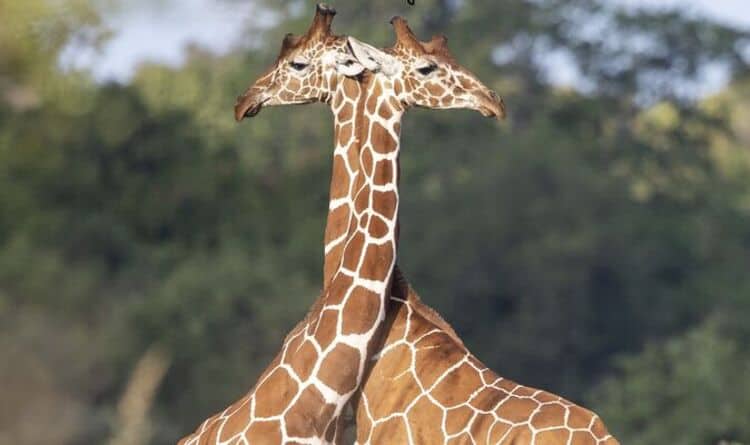The giraffe is nearly down. Two men have stretched a thick black rope in front of the animal, to trip her up. The giraffe hits the rope, and the plan seems to be working until she gains a second wind and breaks into a fresh run. Her body sways backward and forward like a rocking horse being pulled along on a dolly. Six more people grab onto the ends of the rope, and the group runs behind her, holding tight, pitting their meager strength against her weight. It would be no contest, were her veins not coursing with tranquilizer. She loses her footing and careens forward, her legs splaying out behind her. But her seven-foot-long neck still stretches resolutely skyward. A woman leaps from behind her back, collides with her neck midair, and rugby-tackles it to the ground. People run over, carrying a hood and a drill. The giraffe—an emblem of verticality—is now fully horizontal.
The team of people who have drugged, tripped, and tackled the giraffe is a mix of scientists, veterinarians, and rangers who study giraffes in the few parts of the world where the animals still live. Giraffes are so beloved and familiar that it’s tempting to think their numbers are solid and their future secure. Neither is true. Giraffe populations have decreased by 30 percent over the past three decades. Only 111,000 individuals remain. There are at least four African elephants for every giraffe. To safeguard a future for giraffes, researchers need basic information about how far they roam. GPS trackers can offer answers, but to get a tracker on a giraffe, one must first take it down.
This is harder than it sounds, and it sounds hard. Etorphine—an opioid about 1,000 times more potent than morphine—is the preferred anesthetizing agent, but some giraffes resist doses that would knock out an elephant. And unlike elephants, many of them respond by breaking into a run. Also, etorphine depresses a giraffe’s breathing, reduces its heart rate, and increases its blood pressure. The drug is tolerable in the short term, but after only 15 minutes, it can cause problems for an animal whose heart must pump blood up a seven-foot neck. A darted giraffe must be tripped as quickly as possible. Once it’s horizontal and restrained, the team can immediately reverse the etorphine with a second drug, while attaching a tracker.
“You want it to stand up as soon as possible,” says Sara Ferguson, a vet for the Giraffe Conservation Foundation, and the woman who body-slammed the giraffe’s neck. Though they look slender, giraffes are massive, sturdy animals. The head and neck alone can weigh 600 pounds—more than a large black bear. When males fight over mates, they swing their necks in long arcs to bludgeon each other with their reinforced heads. Their necks can take the impact of one airborne vet.
Until recently, giraffes have suffered from surprising scientific neglect. Few researchers have studied them in the wild, so even basic aspects of their lives remain mysterious. Perhaps that’s because giraffes live in what researchers suspect are protean societies lacking the cohesiveness of elephant herds or lion prides. Whatever the reason, one of the world’s most conspicuous creatures has somehow been overlooked. The same goes for its impending extinction. And without fanfare, many other major animal groups—insects, birds, and amphibians—have also declined precipitously. Quite a few of the public’s favorite wild animals, including lions, cheetahs, and gorillas, are in greater peril than is widely realized. But, according to a 2018 study, this gap between rose-tinted perceptions and dire reality is greatest for giraffes. Their prevalence in the zeitgeist has masked their disappearance from the planet. In 2010, eight times as many Sophie the Giraffe teething toys were sold in France alone as there are actual remaining giraffes. In 2016, the number of Britons who watched a giraffe kick a lion in Planet Earth II exceeded the giraffe population by more than a hundredfold. That same year, the International Union for Conservation of Nature reclassified the giraffe as “vulnerable” to extinction. Even this grave assessment might be too optimistic: New genetic evidence suggests that the giraffe may actually be four separate species that have been evolving on their own for 1 million to 2 million years. The iconic animal faces several falls instead of one.
Ferguson and her colleagues are trying to find out how the giraffe became so endangered, and how to save it while they still have time. They’re traveling across the few parts of Africa where giraffes still exist, to affix trackers to several hundred individuals. The process is exhilarating, but also dangerous—for both humans and giraffes. Julian Fennessy, the foundation’s founder and director, only recently recovered from three broken ribs and a dislocated shoulder, sustained when the neck of a stumbling giraffe fell across his torso. He sometimes has to reassure tourists on safari that he is not a poacher. On occasion, his team has had to free tranquilized giraffes that got stuck in trees, or steer them away from rivers.
Imagine you are one of these giraffes. You are the tallest thing for miles. Everything about you defies gravity. Your hips and shoulders are level with the tops of many acacia trees, which to shorter mammals are the world’s ceiling. Your head rises 19 feet into the air. As your sharp gaze sweeps over vast swaths of savannah, you see five jeeps driving toward you.
Riding in the jeeps, we head toward a group of giraffes. I’m in one of the back jeeps, standing next to two men from the Kenya Wildlife Service. We watch the animals graze quietly, using their long, prehensile, bizarrely bluish tongues to rip foliage from the trees’ thorny branches. Giraffes evolved from short-necked ancestors, and whether they stretched to feed on leaves that are beyond the reach of competitors, or to swing their head with greater force during ritual combat, or to keep an eye on approaching predators, they ended up with a neck that’s more than twice as long as that of any other living animal. They’re tall in a way that the planet hasn’t otherwise seen since the dinosaurs’ reign. On Kenya’s Laikipia Plateau, where the landscape is all flat-bottomed clouds and flat-topped acacia trees, they tend to stick out.
From the lead jeep, Dominic Mijele, an experienced vet from the Kenya Wildlife Service, selects a female—the one that Ferguson will later tackle—and uses a tranquilizer gun to shoot a pink-tufted dart at her. His aim is perfect. The dart embeds in the giraffe’s right shoulder and delivers its etorphine payload. The female twitches nonchalantly, as if bitten by a horsefly, and returns to eating. For a few minutes, nothing happens. Then, she starts running.
Unexpectedly, a calf runs behind her. It can’t be more than two weeks old, but it was born taller than most of the people pursuing it. Its presence complicates matters, but it quickly takes itself out of the equation by crouching and hiding, flattening its neck in a most un-giraffelike way. Its mother, meanwhile, leads the jeeps on a chase.
We tear after her, swerving between the trees and occasionally bulldozing them. When the terrain allows, we leap out and sprint after her, ducking branches covered in inch-long thorns. If the giraffe falls backwards, she risks serious injury to her head and neck. Taking a page from The Empire Strikes Back’s playbook, the team tries to wrap ropes around her legs and guide her into a safer forward stumble.
After Ferguson brings her down, four rangers sit astride her neck like bobsledders. Someone slips a hood over the giraffe’s head so she can’t see. Another threads a device into a nostril to collect data on the animal’s breathing. More than a dozen people surround the giraffe to measure her, collect samples of her skin and DNA, and pick off ticks, while sloshing water on her side to keep her cool. With the effects of the etorphine reversed, the animal is fully conscious, but calm. Nonetheless, everyone stays back from her long and powerful legs, which can deliver a lion-disemboweling kick.

A whole crew of scientists and veterinarians is required for the giraffe-collaring process, during which the 1,500-pound animal is kept awake and stabilized. (Tyler Schiffman)
At the giraffe’s head, Fennessy kneels down and begins to attach the tracking device—a black box, no bigger than a pack of cards. Some people call it a collar, but it’s not meant for the animal’s neck. Nearly two decades ago, when Fennessy’s team first tried tracking giraffes with GPS, it used gigantic collars adapted from those used on elephants, but the giraffes just bent their heads and slipped the devices off. It also tried fixing the collars in place with elastic straps, but feared this might restrict the animal’s esophagus. Head harnesses weren’t quite universal enough to fit the unique head shapes of each giraffe species, and creating one for each species was too expensive. Eventually, the team hit upon the perfect solution: Fix the tracker to a giraffe’s ossicones, the pair of hornlike structures on top of the animal’s head.
Giraffes hit each other with their ossicones, so these structures are thick, bony, and insensitive, with only one nerve at their base. When Fennessy drills a hole in one of them, his subject barely reacts. He threads a steel bolt through the hole, and fastens the unit in place. Once it’s secure, the hood is removed, the men on the neck get off, and the giraffe lifts her head. The seven vertebrae in her neck—the same number as in a human’s—are connected by ball-and-socket joints like those in our shoulders, so instead of lifting up like a rigid beam, her neck snakes upward in an almost reptilian way. She staggers up, and Fennessy slaps her on the rump to get her moving. After a few unsteady steps, she walks off. Somehow, whether through her reportedly excellent (but seldom tested) eyesight, or through low, infrasonic calls (that have long been suspected but never documented), the mother detects her hidden calf, and makes a beeline toward it.
When i’d arrived in kenya, I’d assumed that the primary threat to giraffes was poaching. And people do kill giraffes, with guns, bows, and spears. They snag their legs using circular traps lined with thorns or metal shards. They strip the wires from vehicle tires to make snares that they dangle from trees or scatter on the ground. In Uganda, Ferguson desnared dozens of giraffes just last summer.
“We’ve swept an area and come back literally the next day to find new snares,” she says. Four of the 11 giraffes the team collared in Kenya in 2017 were likely poached, “a much higher rate than anyone suspected,” says Jared Stabach of the Smithsonian Conservation Biology Institute. Unlike elephants, rhinos, and pangolins, giraffes aren’t poached to supply a big, illegal, international market in body parts. Instead, in countries like Kenya, people mostly kill giraffes for their meat—to feed themselves, their families, their villages. “They’re a shitload of food,” Fennessy says.
Poaching is only one threat among many to giraffes. It’s a significant threat, it’s easy to visualize, and it offers an antagonist to focus on—but there are less direct and dramatic ways of killing a giraffe.
Since the 1970s, Kenya’s human population has more than quadrupled, and it is projected to double again by 2050. Livestock populations have also ballooned, and now collectively outnumber wildlife biomass by a factor of eight. Not coincidentally, wildlife numbers have declined by about 70 percent. As the human world expands, the world for wildlife contracts. Giraffes are left with few resources as more land is dedicated to agriculture and livestock. Humans’ and other animals’ very presence can make life harder for giraffes. They flood the landscape with loud noises, divert water for irrigation, and overgraze the land. “They chop down trees for charcoal, so there’s nothing to eat,” says Symon Masiaine, who leads a team called Twiga Walinzi, or “Giraffe Guards.” “The livestock disturb [giraffes] from grazing. The dogs chase them.” People block giraffe migration routes with fences and roads.
The story of the giraffe’s decline is not one of villainous poachers and murdered animals. It is a story of two species dealing with the same crowded, rapidly changing world.
Growing human populations and the fragmentation of the landscape are the biggest culprits behind the decline of giraffes. David O’Connor, who researches population sustainability at San Diego Zoo Global, points out the problem on three maps. The first shows where giraffes lived in the 18th century—a broad, continuous brushstroke sweeping over much of Africa. The second shows their current whereabouts—a few pathetic splotches totaling just 10 percent of their former range. The third superimposes all of Kenya’s ongoing and planned development projects onto that shrunken range, which becomes further fragmented. The pattern reminds me of the one I’ve been staring at for days: the islands of tawny brown on a giraffe’s hide, separated by unbroken white lines. It’s as if the giraffe’s woes have been etched onto its skin.
“When the land is not open, it reduces the animals’ ability to be flexible to change,” Fennessy says. And change is certainly upon them. Kenya’s temperatures are set to rise by an estimated 2 degrees Celsius by 2060. Giraffes, already confined to the driest regions that are untouched by agriculture, must now contend with shorter rainy seasons, more erratic rainfall, and more severe and prolonged droughts. Pastoralists, who once had free rein of Kenya’s lands, must deal with the same challenges. Decades of decisions by British colonialists and the postcolonial government have severely restricted their lifestyle. Constrained and marginalized, they now compete with giraffes for the same dwindling resources, through the same climatic upheavals. Conflict is inevitable, and the giraffes almost always lose.
“All of these things make the animals immune-compromised and more susceptible to disease,” says Maureen Kamau, a veterinary fellow with the Smithsonian Conservation Biology Institute. Giraffes across East Africa have been known to carry a mysterious skin disease that causes oozing, crusty lesions on their limbs and necks. Other species are experiencing similar problems: In Laikipia, a previously healthy population of wild dogs was all but wiped out in 2017 by a virus that spread from domestic canines.
These combined stresses are especially costly for giraffes, which reproduce only a few times in their lives, and gestate for 15 months. “Anything happens during that period and it’ll lose the young one, and when it’s got all these other threats, it won’t breed,” Fennessy says.

Giraffe herds may have a mix of males and females or be segregated by sex. We still know strikingly little about the animals’ range and behavior. (Davis Huber)
If animals cannot move through a fragmented world, humans may have to move them. In August 2018, people living along a particular road in northern Uganda were treated to a peculiar sight: a large green truck with shrubbery strapped to its sides, five Nubian giraffes peering out through its open roof. The driver went slowly so as not to hit any bumps. The giraffes, for their part, were remarkably calm during the 10-hour drive. “We drove past schools, and kids would flood out,” Ferguson says. “It was the first time many of them had seen a giraffe, let alone five driving through their town.”
Nubian giraffes are a subspecies of northern giraffe, and just 2,645 are left in the wild. More than half of those live in Murchison Falls National Park. The Uganda Wildlife Authority has relocated small groups to other protected areas, and all the populations are now growing. But this strategy has limits, because the new and growing populations are still isolated islands in a changing world. And in some countries, the giraffes have nowhere to go. Kenya’s national parks and reserves cover just 8 percent of the country, and most big mammals—including almost all reticulated giraffes—live outside them. If the giraffes are to survive, they will have to do so in the presence of people.
The trick is to make the presence of giraffes more valuable to local communities than either their flesh or their absence. Consider Niger. In the mid-1990s, it was home to the last 49 West African giraffes, all of which lived outside national parks and on community-owned lands. Conservation groups supported those communities by offering loans, building wells, and providing ecotourism opportunities. Such measures, together with a strict government-enforced ban on killing, brought the West African giraffe back from the brink. Today, 600 of them graze the croplands.
In Kenya, many communities have turned their lands into conservancies—areas where livestock grazing is more carefully managed. In exchange for giving wildlife refuge, some communities receive revenue from ecotourism operators or development programs run by conservation organizations; the state-operated Kenya Wildlife Service offers veterinary support and ranger training. This model, first developed decades ago, has bloomed exponentially in the past two decades, such that community conservancies now cover more land than Kenya’s national parks.

Most conservancies aren’t fenced, though, and animals can easily move beyond them. “They come back with injuries,” says Mijele, the vet—if they come back at all. Each conservancy is still a fragment, but some are starting to connect, creating large, continuous refuges. The famous Maasai Mara National Reserve is now surrounded by community conservancies in the northern areas that cover almost as much ground as the reserve itself. The Northern Rangelands Trust is an especially successful umbrella group of 39 conservancies that cover more than 10 million acres. Slowly, the land is being defragmented.
The collaring team hopes that its data can help. By showing where giraffes go, the team can help conservation groups prioritize areas that need the most protection. Jenna Stacy-Dawes, a research coordinator from San Diego Zoo Global, shows me a map of the privately owned area where the team has tagged giraffes. Squiggly colored lines snake across its borders, each representing a tracked giraffe. Most eventually roam outward, into community-owned lands. One yellow line heads north and abruptly ends. The giraffe’s tracker stopped transmitting in June 2017, just a few weeks after it was attached.
The giraffe guards went up to investigate, and discovered that the giraffe had been poached for food near a primary school in Morijo. The team responded by organizing education days focused on giraffe conservation, starting wildlife clubs, and donating desks and textbooks—the school’s first educational materials. “People there are now some of the biggest supporters of giraffes,” Stacy-Dawes says. “And they’re seeing that giraffes are providing for their families in other ways.” The story of the giraffe’s decline is not one of villainous poachers and murdered animals. It is a story of two species dealing with the same crowded, rapidly changing world. Only through coexistence will the tale have a happy ending.

Toward the end of the collaring expedition, I ride with Steve Lenguro, a vet from the Kenya Wildlife Service. He points out a giraffe, but all I see is a tree. Then the tree turns to look at us.
Over three days, the team fixes tracking units to seven giraffes. Every collaring is challenging in its own way. On one occasion, the tranquilizer dart doesn’t fully penetrate its target, and Mijele is forced to pick a second. The darts fall off both animals, and they run into a grove of trees that are tall enough to obscure even their lofty profiles. The jeeps lose track of them, and the convoy is forced to drive through thick bush. Finally, one of the animals breaks into the distinctive etorphine-induced run, and vaults a ditch that the trucks can’t pass. We get out and run again, in sweltering mid-morning heat and through thick grass. David O’Connor twists his ankle. The rangers get the giraffe down, and Fennessy yells for someone to inject the reversal drug, but it’s in a jeep that became separated from the main group.
Fennessy is visibly and audibly annoyed about how long it takes for the drug to arrive. He’s not pleased that some of the rangers are kneeling on the animal’s neck instead of sitting on it—a position that he says places less pressure on joints and blood vessels. The Kenyan team, meanwhile, finds Fennessy’s attitude patronizing. “We’ve done this hundreds of times before,” Lenguro tells me. After some tense debriefings, egos deflate, and the team settles into a groove. It doesn’t lose a single animal.
The seventh and final giraffe—a young male—doesn’t even run. It takes the dart, walks 100 yards, and slumps against a tree. It looks preposterous, its body slack but supported, its neck stuck in the branches. The long thorns can’t pierce its thick skin, but they probably aren’t pleasant either. The etorphine is still coursing through his body, and clearly having a stronger effect than anyone anticipated. Working urgently, the team wraps a rope around the body and, with at least six people pulling, drags the giraffe to the ground. The drug is reversed, the hood goes on, and everything proceeds as planned.
Imagine what a shock it would be to be that giraffe, to come to in a posture that you haven’t experienced since you dropped out of your mother and first got to your feet. Whatever was fogging your senses has cleared, but your eyes are still covered. You lash out with a hoof, connecting with nothing but air. A loud drilling noise rumbles through your skull, and you lash out again. Your vision returns. You lift your head, snake your neck upward, and rise to your proper place—upright, aloft, above all things.
This article was first published by The Atlantic on 1 April 2021. Lead Image by Davis Huber.
What you can do
Support ‘Fighting for Wildlife’ by donating as little as $1 – It only takes a minute. Thank you.







Leave a Reply